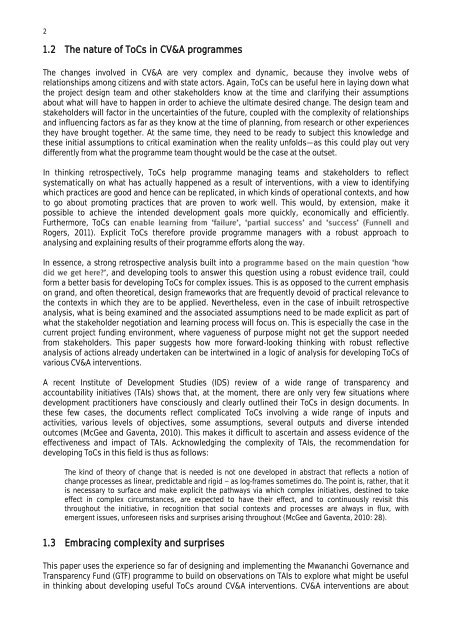Citizen voice and state accountability: Towards ... - Capacity4Dev
Citizen voice and state accountability: Towards ... - Capacity4Dev
Citizen voice and state accountability: Towards ... - Capacity4Dev
- No tags were found...
Create successful ePaper yourself
Turn your PDF publications into a flip-book with our unique Google optimized e-Paper software.
21.2 The nature of ToCs in CV&A programmesThe changes involved in CV&A are very complex <strong>and</strong> dynamic, because they involve webs ofrelationships among citizens <strong>and</strong> with <strong>state</strong> actors. Again, ToCs can be useful here in laying down whatthe project design team <strong>and</strong> other stakeholders know at the time <strong>and</strong> clarifying their assumptionsabout what will have to happen in order to achieve the ultimate desired change. The design team <strong>and</strong>stakeholders will factor in the uncertainties of the future, coupled with the complexity of relationships<strong>and</strong> influencing factors as far as they know at the time of planning, from research or other experiencesthey have brought together. At the same time, they need to be ready to subject this knowledge <strong>and</strong>these initial assumptions to critical examination when the reality unfolds as this could play out verydifferently from what the programme team thought would be the case at the outset.In thinking retrospectively, ToCs help programme managing teams <strong>and</strong> stakeholders to reflectsystematically on what has actually happened as a result of interventions, with a view to identifyingwhich practices are good <strong>and</strong> hence can be replicated, in which kinds of operational contexts, <strong>and</strong> howto go about promoting practices that are proven to work well. This would, by extension, make itpossible to achieve the intended development goals more quickly, economically <strong>and</strong> efficiently.Furthermore, ToCs canRogers, 2011). Explicit ToCs therefore provide programme managers with a robust approach toanalysing <strong>and</strong> explaining results of their programme efforts along the way.In essence, a strong retrospective analysis built into a, <strong>and</strong> developing tools to answer this question using a robust evidence trail, couldform a better basis for developing ToCs for complex issues. This is as opposed to the current emphasison gr<strong>and</strong>, <strong>and</strong> often theoretical, design frameworks that are frequently devoid of practical relevance tothe contexts in which they are to be applied. Nevertheless, even in the case of inbuilt retrospectiveanalysis, what is being examined <strong>and</strong> the associated assumptions need to be made explicit as part ofwhat the stakeholder negotiation <strong>and</strong> learning process will focus on. This is especially the case in thecurrent project funding environment, where vagueness of purpose might not get the support neededfrom stakeholders. This paper suggests how more forward-looking thinking with robust reflectiveanalysis of actions already undertaken can be intertwined in a logic of analysis for developing ToCs ofvarious CV&A interventions.A recent Institute of Development Studies (IDS) review of a wide range of transparency <strong>and</strong><strong>accountability</strong> initiatives (TAIs) shows that, at the moment, there are only very few situations wheredevelopment practitioners have consciously <strong>and</strong> clearly outlined their ToCs in design documents. Inthese few cases, the documents reflect complicated ToCs involving a wide range of inputs <strong>and</strong>activities, various levels of objectives, some assumptions, several outputs <strong>and</strong> diverse intendedoutcomes (McGee <strong>and</strong> Gaventa, 2010). This makes it difficult to ascertain <strong>and</strong> assess evidence of theeffectiveness <strong>and</strong> impact of TAIs. Acknowledging the complexity of TAIs, the recommendation fordeveloping ToCs in this field is thus as follows:The kind of theory of change that is needed is not one developed in abstract that reflects a notion ofchange processes as linear, predictable <strong>and</strong> rigid as log-frames sometimes do. The point is, rather, that itis necessary to surface <strong>and</strong> make explicit the pathways via which complex initiatives, destined to takeeffect in complex circumstances, are expected to have their effect, <strong>and</strong> to continuously revisit thisthroughout the initiative, in recognition that social contexts <strong>and</strong> processes are always in flux, withemergent issues, unforeseen risks <strong>and</strong> surprises arising throughout (McGee <strong>and</strong> Gaventa, 2010: 28).1.3 Embracing complexity <strong>and</strong> surprisesThis paper uses the experience so far of designing <strong>and</strong> implementing the Mwananchi Governance <strong>and</strong>Transparency Fund (GTF) programme to build on observations on TAIs to explore what might be usefulin thinking about developing useful ToCs around CV&A interventions. CV&A interventions are about
















